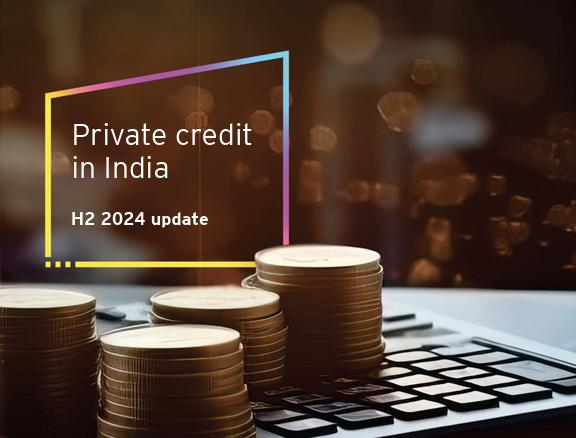Indias Private Credit Surpasses US$9 Billion in 2024 Despite Global Headwinds




Private Credit in India: H2 2024 Comprehensive Report
The second half of 2024 witnessed substantial activity in India's private credit market, with investments totaling USD 3.3 billion across 67 transactions. Despite a decline from the USD 5.9 billion reported in the first half of 2024, this represents a robust 7% year-on-year growth, driven by a record-breaking 163 deals throughout the calendar year. The sector continues to demonstrate strong investor interest and market acceptance as a viable capital solution, notwithstanding several large transactions being deferred to early 2025.
A significant shift occurred in H2 2024, with domestic players dominating the landscape by completing approximately 63% of total deal value, surpassing their global counterparts. Real estate emerged as the most attractive sector, capturing 43% of total investments, followed by consumer durables and financial services. High-value transactions exceeding USD 100 million comprised 50% of the total transaction value, reflecting strong investor focus on refinancing and acquisition financing strategies aimed at asset stabilization and market consolidation.
The competitive landscape intensified considerably, spurred by new Alternative Investment Fund registrations and ambitious fundraising initiatives. A vibrant equity market facilitated companies' access to cheaper financing through equity channels, exerting downward pressure on yields and resulting in lighter covenant structures. This environment creates potential for higher future credit costs due to emerging fund management challenges among newer market participants.
Domestic participation by local investors, driven by diversifying investment requirements and limited fixed income alternatives, continues vitalizing fund availability for private credit managers. The macroeconomic climate presents mixed signals, with optimism regarding geopolitical tension resolution tempering central banker pressure to maintain elevated rates amid concerns over trade barriers and global economic volatility.
The global economic landscape continues experiencing dynamic shifts that reshape investment strategies daily. Potential resolution of Middle Eastern conflicts and prospective peace agreements in Ukraine have improved global sentiment. Combined with increased US oil production and export capabilities, energy price stabilization reduces pressure on central banks to maintain high interest rates.
However, new challenges emerge through heightened trade barriers, nations withdrawing from global health and climate partnerships, and increasingly isolationist policies contributing to market volatility and slower global growth. This uncertainty particularly affects investment decision-making processes, constraining economic momentum across multiple markets.
India's economic growth confronts both global headwinds and domestic challenges. Credit growth decelerated to 11% according to Reserve Bank of India data, while private capital expenditure remains insufficient to drive meaningful economic advancement. Contributing factors include reduced governmental capital expenditure, softening demand environments, tight liquidity conditions, and complex geopolitical circumstances collectively dampening growth prospects through Q2 FY25 and anticipated Q3 FY25.
Despite these challenges, India maintains its position as a global economic beacon with the highest GDP growth rates among major economies, supported by substantial foreign direct investment surges during H1 FY25. The World Bank's Global Economic Prospects report estimates India will grow at 6.7% in FY26 and FY27, significantly outpacing the global rate of 2.7%. The International Monetary Fund projects a robust 6.5% growth rate for India in CY 2025, confirming previous forecasts.
Global inflation battles appear largely successful, with rates expected to decrease from 9.4% in CY 2022 to 3.5% by CY 2025. Advanced economies anticipate reaching inflation targets sooner than emerging counterparts due to varied economic conditions. Public debt forecasts remain concerning, expected to exceed USD 100 trillion or approximately 93% of global GDP by CY 2024, with emerging economies bearing significant fiscal pressure.
India's financial landscape in H2 2024 presented dynamic conditions as private credit investors strategically navigated evolving market circumstances. Credit deployment by scheduled commercial banks demonstrated strong growth, particularly among public sector banks driven by improved profitability and robust asset quality. However, credit expansion pace moderated due to regulatory prudence preventing market overheating in specific segments.
Net Interest Margin contraction suggests future developments as rising deposit costs interact with moderating credit growth patterns. ICRA's downward revision of credit growth expectations for FY25 to 10.5%-11% from earlier forecasts reflects significant shifts, primarily due to retail and unsecured lending deceleration. This adjustment marks a strategic pivot toward supporting MSMEs and infrastructure development through targeted government incentives.
Agricultural credit growth remained steady at 12%, demonstrating stability within the dynamic financial environment. MSMEs experienced robust 13% credit growth, highlighting increased focus on leveraging small and medium enterprises as economic catalysts. Industrial sectors witnessed modest 7% credit growth, with electronics and pharmaceuticals gaining particular traction. Personal loan segments grew 12%, reflecting evolving consumer behavior in housing and vehicle financing.
NBFCs faced moderated AUM growth of 13% while adapting strategies amid tighter regulations. These entities demonstrated resilience through funding diversification and international borrowing strategies. Their increasing reliance on private credit markets for sophisticated project financing introduces innovative elements to the financial landscape. Debt mutual fund trends revealed nuanced shifts, with credit risk fund AUM declines indicating evolving investor preferences toward higher-yield private credit investments.
The Insolvency and Bankruptcy Board of India's latest quarterly newsletter reveals substantial Corporate Insolvency Resolution Process activity. By September 2024, 8,002 cases were admitted with 6,039 closed. Notably, 3,409 corporate debtors secured resolution through approved plans, while 2,630 proceeded to liquidation. However, average resolution time reached 691 days, significantly exceeding the intended 180-day timeline, prompting government initiatives to streamline processes through increased monitoring and additional judicial benches.
Financial recoveries under IBC jurisdiction total approximately USD 42 billion since inception, representing a 31% recovery rate. Recent data suggests declining recovery rates to 18% for the quarter ending September 2024, reflecting ongoing challenges in optimizing creditor outcomes. Key judicial decisions continue shaping insolvency practices, with Supreme Court rulings establishing IBC precedence over competing claims and emphasizing statutory waterfall mechanisms.
SEBI continues strengthening market discipline through enhanced regulatory frameworks. New mandates require credit rating agencies to downgrade ratings to 'D' upon any payment delays, fostering greater transparency and accountability. The regulatory climate for Alternative Investment Funds evolves to ensure robust investor protection while maintaining capital structure flexibility through enhanced due diligence requirements and prudent borrowing frameworks.
The private credit sector maintained strong momentum in H2 2024 with approximately 28 new Alternative Investment Fund registrations, demonstrating persistent market interest. Notable fundraising efforts include Avendus targeting USD 466 million for their credit fund, attracting both domestic and international investments. The fundraising pipeline remains robust with multiple prominent players pursuing significant capital commitments.
Deal activity showcased vibrant dynamics with 67 transactions valued over USD 10 million aggregating approximately USD 3.3 billion. These transactions contributed to full-year deployment of USD 9.2 billion, reflecting 7% year-on-year growth from CY 2023 and illustrating increasing private credit adoption as a viable financing solution across multiple sectors and transaction types.
The landscape experienced notable shifts with domestic private credit players completing approximately 63% of total deal value, surpassing global fund participation. Real estate emerged as the leading sector attracting 43% of total investments, while consumer durables and financial services captured substantial interest. Infrastructure and renewable energy sectors demonstrated growing focus toward sustainable and future-oriented projects.
Transaction size distribution varied significantly, with deals exceeding USD 100 million accounting for 13% of total transactions, confirming sector movement toward high-value engagements. This trend reflects sophisticated investor strategies focusing on refinancing, acquisition financing, and strategic asset consolidation initiatives across India's evolving private credit market.
India's private credit market demonstrates remarkable resilience despite facing multiple challenges including geopolitical uncertainties, regulatory adjustments, and evolving competitive dynamics. The substantial domestic player participation provides optimism, reflecting an adaptive market committed to sustained growth amid economic headwinds and changing investor preferences.
Corporate bond market projections indicate 8.9% to 9.5% growth by March 2025, underscoring its pivotal role as an alternative to traditional bank financing. Private placement growth from USD 38.45 billion in 2014 to nearly USD 100 billion in 2024 demonstrates efficient capital raising capabilities. Online Bond Platform Providers democratize market access, transforming the investment landscape and enhancing retail investor participation opportunities.
Strategic government initiatives including comprehensive tax reforms and international financial services regulation improvements support market development. Collaborative efforts between traditional banks and private credit players create synergistic opportunities for bespoke financing structures and efficient capital allocation. These partnerships position market participants to handle regulatory capital costs effectively while expanding resource diversity and economic interaction capabilities.
The intricate credit deployment and growth environment presents numerous opportunities shaped by regulatory frameworks, sectoral variations, and innovative financing solutions. India's financial future appears promising, characterized by dynamic market conditions, strategic adaptations, and sustained investor interest in private credit as a fundamental component of the evolving economic landscape.
Private Credit Report H2 2024
EYhttps://www.ey.com › en-in › strategy-transactions
Comments